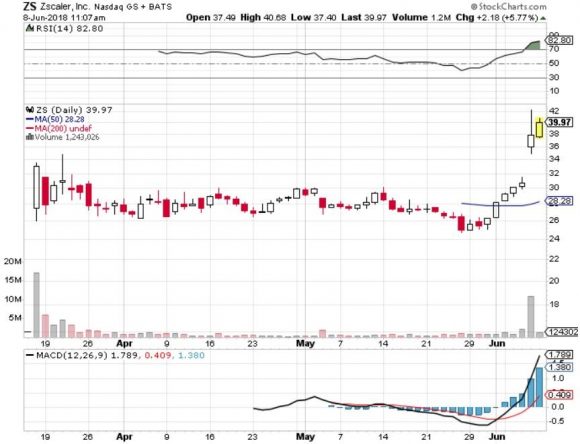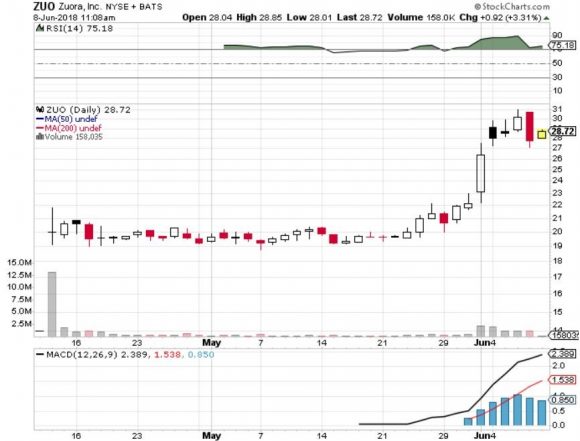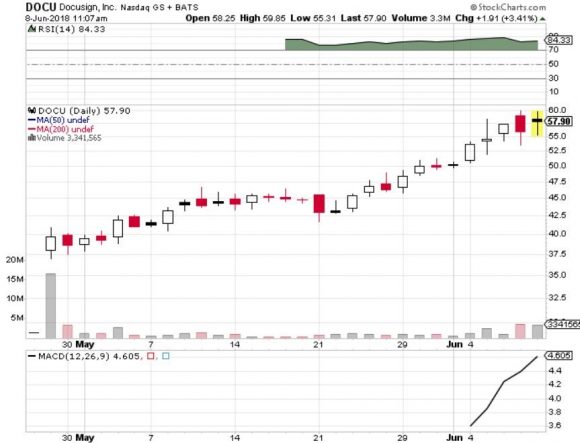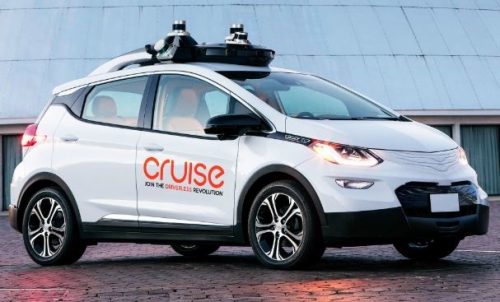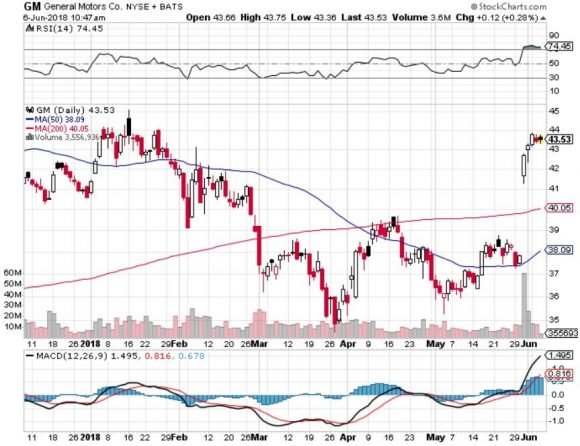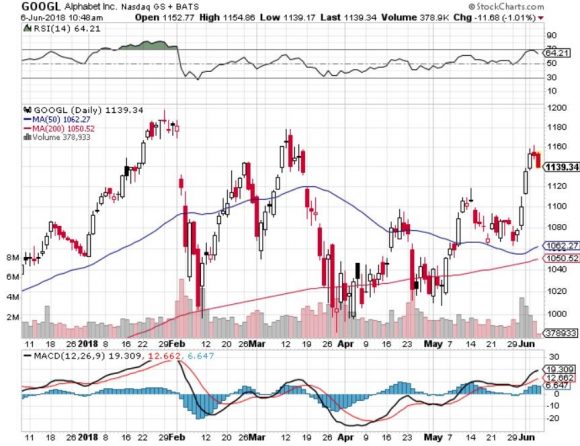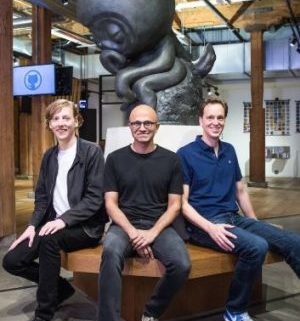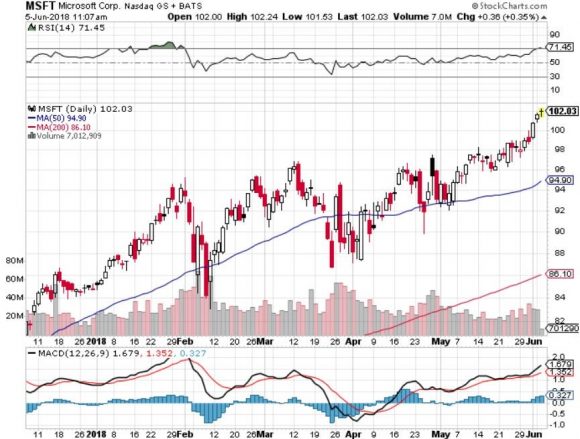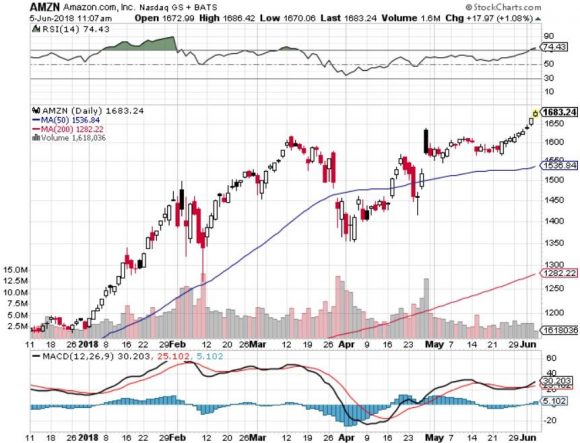Mad Hedge Technology Letter
June 11, 2018
Fiat Lux
Featured Trade:
(HERE ARE SOME GREAT SECOND-TIER CLOUD PLAYS TO SALT AWAY),
(DOCU), (ZUO), (ZS), (MSFT), (AMZN)
The year of the cloud has been one of the most successful themes for the Mad Hedge Technology Letter since inception and rightly so.
The heavy hitters are knocking it out of the park with the top gangbuster firms facing no impediment to success.
As these firms crack on, it seems there is not a day that passes by where Amazon (AMZN) or Microsoft (MSFT) do not close up 1% for the day.
If you are feeling nervous and believe the top cloud plays are getting too frothy for your taste, even though they are not, it is time to look at alternative parts of the cloud ecosphere that could tickle your fancy.
The second-tier cloud companies focusing on a particular niche of the market is the perfect place to identify companies that are growing at higher rates than the top cloud companies in terms of revenue expansion.
Amazon, because of its sheer size, will find it harder to double its revenue in the same amount of time as cloud companies with annual revenue of just a few hundred million dollars.
Zscaler (ZS) is a cloud security company that I advised readers to buy on April,16, at $29 and after a blowout quarterly report the stock touched the $42 handle intraday.
This company is a solid buy, especially in light of the General Data Protection Regulation (GDPR) and a newfound, broad-based emphasis on Internet security that will usher in a new injection of cloud security spending.
Zscaler CEO Jay Chaudhry delivered a glorious quarterly performance and the only direction this company is going is up.
All told, Zscaler processes in excess of 45 billion Internet requests per day during peak periods.
It detects and blocks more than 100 million daily threats while performing more than 120,000 unique daily security updates.
The end result is far superior security than traditional outlets. That's the whole point.
The cloud security company was able to inspire business to a 49% YOY pace of growth and calculated billings were up 73% YOY to $54.7 million.
The quarter's success didn't stop there with operating margins gaining 9% YOY helping Zscaler go cash free positive for the quarter.
The type of security products it offers is part of an annual $17.7 billion market and rapidly expanding.
Firms are incentivized to adopt these products because reduced cost on bandwidth and lower network equipment costs benefit the bottom line.
A mobile dominant world is fast approaching, and Zscaler has positioned itself perfectly to take advantage of the new pipeline of business coming its way.
The slew of new signed contracts reinforces this trend.
The most prominent deals were with a Fortune 500 medical equipment company that purchased a bundle including a Cloud Firewall, Sandbox and Data Loss Prevention for 40,000 users.
It followed that up with a deal with a European bank that added the business bundle with SSL inspection and data loss prevention (DLP) for more than 70,000 users driven by the business moving to Office 365.
Zscaler kept going strong with another Fortune 500 tech company joining its lineup, integrating the transformation bundle for 20,000 employees and contractors just six months ago,
They were thrilled with the products, leading them to buy an additional 25,000 seats and now have all 45,000 employees served by Zscaler.
A global 500 IT services and products company in Asia went for the entry level professional bundle covering10,000 users in Q2.
It expanded the next quarter with the same bundle for more than 130,000 users domestically.
Forecasted revenue is expected to be in the range of $184 million to $185 million, substantially larger than the $126 million of revenue in 2017.
Once annual revenues start eclipsing the several billion-dollar mark, growth becomes tougher to grind out.
Zscaler is headed by an old hand and understands the market in detail.
The firm will be in a growth sweet spot for the foreseeable future. Subscribers who do not mind taking on the added risk could expect these investments to pay off many times over.
Another niche cloud company Zuora (ZUO) is performing briskly.
I recommended this stock the same day as Zscaler when it was trading at $20.50. The stock is up big, rocketing to $28.50 at the time of this writing.
Zuora is a company focused on software that helps companies manage their subscriptions business, which has been all the rage for tech companies.
The software as a service (SaaS) model has become the de-facto standard to bill for tech services, and Zuora helps automate and execute.
First quarter revenue surged 60% to $51.7 million.
Zuora's retention rate of 110% increased to 112%, demonstrating that existing customers buy premium add-ons and stick around in its ecosystem.
Zuora increased the numbers of clients with an active contract value greater than $100,000 by 6% to 441, resulting in a net add of 26.
Zscaler and Zuora are around the same size and could experience similar bullish price trajectories in the stock going forward.
DocuSign (DOCU), a digital signature software company, is another niche player whose services have been valuable in the business environment.
Instead of scrawling out your name with a quill and ink, clicking to sign makes the process faster than ever.
The stickiness of its services led Forbes to anoint DocuSign as the fourth best cloud company on the Forbes Cloud 100 list in 2017.
Last year saw DocuSign blow past the half a billion-number bringing in revenue of $518 million, up 36% YOY.
The lion's share of its business comes from its subscription business carving out $484 million in 2017, passing the $348 million in 2016.
DocuSign set an IPO price range between $24 to $26 in April 2018, and the stock has more than doubled to $58 today.
Do not fight against the cloud; embrace it like your lovable pet dog. There is no reason to short these stocks because chances are likely you will get badly burned on these ultimate buy on the dip stocks.
However, DocuSign has seldom even dipped, even in the face of a trade war, crushing dip buyers' dreams.
It has gone up in a straight line.
Only once since its late April IPO has there been a pullback of more than $1.50, and that happened in mid-May when the stock went from $45.50 to $43.
Remember, the trend is your friend.
Zscaler's 37% bump to its share prices after the earnings beat is why you want to get into this stock.
The moves up are legendary.
Zuora's earnings beat earned them a not-too-shabby 20% one-day return as well.
No matter how well Amazon does, there is no 37% up move in one day unless it finds the cure for cancer in a single pill form.
As Amazon and Microsoft grow stronger, so does the appetite for these niche cloud services.
The tide will lift all boats and choosing either a dinghy or a luxury yacht will stand you in good stead.
_________________________________________________________________________________________________
Quote of the Day
"I don't care about revenues," - said Cofounder and Executive Chairman of Alibaba Jack Ma.
Mad Hedge Technology Letter
June 8, 2018
Fiat Lux
Featured Trade:
(WILL SYNBIO SAVE OR DESTROY THE WORLD?),
(XLV), (XPH), (XBI), (MON), (IBM), (GOOG), (AAPL), (CSCO)
Mad Hedge Technology Letter
June 7, 2018
Fiat Lux
Featured Trade:
(THE NEW TECHNOLOGY PLAY YOU'VE NEVER HEARD OF),
(GM), (UBER), (WMT), (GOOGL)
Welcome to the new cutting-edge high-tech play - General Motors (GM).
The tectonic shifts permeating through the tech landscape seem like there is no end.
Another blockbuster announcement hit the airwaves melding together a brand-new partnership between SoftBank and GM's self-driving unit Cruise.
SoftBank invested an eye-popping $2.25 billion into Cruise for a 19.6% stake, adding to its scintillating arsenal of big data assets focusing on transportation including Uber, India's Ola, China's DiDi, and Southeast Asia's Grab.
GM disclosed it will divvy up a further $1.1 billion into the deal.
The Mad Hedge Technology Letter has been an astute follower of the autonomous driving technology race because the technology will be the next proprietary technology to change the world, creating enormous windfalls for the few involved.
The timeline commences later this year, when Waymo, a subsidiary of Alphabet (GOOGL), rolls out a robo-taxi commercial service.
General Motors is right on Waymo's heels rolling out its own commercial service "sometime in 2019."
This momentous investment by SoftBank solidifies (GM) as the No. 2 industry player going forward.
This is a huge victory.
The historic shift symbolizes the next gap up in the technology movement.
Tech stocks have been on a tear of late leaving other equities in the dust.
Waymo was the first mover and confidently never relinquished the top-dog position while avoiding any big disasters along the way.
The unparalleled success of Waymo's self-driving unit has led analysts to put a valuation figure ranging anywhere from $75 billion to $125 billion.
GM paid a measly $1 billion for Cruise in 2016, which is peanuts in today's thriving tech landscape.
Analysts estimated the valuation of Cruise at $4 billion just before the SoftBank investment. The almost 20% stake for $2.25 billion puts the new valuation number over $11 billion, three times more than analysts initially speculated.
Tech acquisitions have exploded in 2018 and show no signs of slowing down.
The hallmarks of Waymo's operation hinge on safety-first initiatives, which went a long way to upholding its industry leader position.
The safety-second attitude led Uber to attempt to short circuit its way to the top from a position of weakness to ill effect.
Uber's technology failed, and the result of the Phoenix, Arizona, casualty was a suspended operation.
Game over.
To stick the blade cleanly through the back, Uber CEO Dara Khosrowshahi revealed that talks are ongoing between Waymo and Uber to add Waymo's technology to Uber's broker app service.
This revelation is interesting considering Uber infuriated Waymo. It means Uber will effectively recede itself from competing with Waymo in self-driving technology.
The company doesn't need to anymore and it burns too much cash.
The protracted court ruling revealed Uber had stolen trade secrets using poached Waymo engineers.
This time, it really is the nail in the coffin for Uber's self-driving technology.
It will change strategy and refine its core app that made them famous in the first place.
The SoftBank investment into Cruise has clear synergies with Uber.
If Waymo refuses to go into bed with Uber, the natural logical step would be for the GM Cruise technology to be integrated with the Uber platform since they are both SoftBank investments.
SoftBank's management will clearly push for this arrangement. It makes no sense to use the Lyft platform with the GM Cruise division.
The tie up with GM Cruise was the catalyst for Uber seeking "talks" with Waymo, knowing very well if talks failed, a backup plan was hatched and would be able to partner up with Cruise's technology.
This is the luxury Uber has now since it is part of the SoftBank umbrella along with the GM Cruise division.
This nullifies the existential threat Uber was anxious about as it is guaranteed a certain slice of the pie leading to material future revenue stream post IPO.
The SoftBank investment is a stamp of approval for the quality of GM self-driving technology.
SoftBank only invests in the most innovative firms.
The conundrum with legacy car companies is that the bulk of revenue is reliant on selling combustion-engine cars that will soon become obsolete.
Any large commitment to R&D, unfocused on its main profits levers, hurt margins. Investors do not buy American car manufacturers that operate at a loss.
Therefore, legacy companies are penalized for spending on new businesses that could be hit or miss.
They stick with their bread and butter through thick and thin because that is what investors expect them to do. This was why Walmart (WMT) sold off when it acquired a stake in Flipkart.
A certain type of Walmart investor would be aghast at this unexpected new direction and amount of dollars drained.
In support of Walmart, CEO Doug McMillon has been positively vocal about the pivot to tech and e-commerce.
It should not be a surprise.
Old technology gets swept into the dustbin of history. Examples are legion.
Let me explain why.
The shift from horse-drawn carriages to the automobile was an equally jaw-dropping development at the time.
Not all horse-drawn carriage manufacturers were able to make the massive leap from creating simple horse-carriage passenger vehicles to automotive vehicles with combustion engines.
When Abraham Lincoln was transported to the Ford Theatre the night of his assassination, he was rolling in a Studebaker horse-drawn carriage.
Studebaker, which was established in 1852 with $68 of capital and a tool belt, was the only top-notch horse-drawn carriage manufacturer to make the gigantic shift from horse-drawn carriage builder to automotive producer.
The other players shriveled up and waved the white flag.
Studebaker actually manufactured both horse-drawn carriages and cars from 1902-1920.
The company mutated again during World War II making military vehicles, M29, M29C, and engines for B-17 bombers.
Financial mismanagement ruined the company. In 1963 it shuttered its South Bend, Indiana, factory and then went out of business by 1967, missing out on a chance to take on Uber and Waymo by about 55 years.
Such are the annals of history.
(GM) is the first American legacy car company to make the complicated transition from traditional American car producer to self-driving technology player.
And it could be the only one.
The deal will raise the price range for the Uber IPO planned for 2019. The (GM) cruise division will report financials separately from the rest of the (GM) balance sheet, which could be the precursor to spinning it out as its own company creating more shareholder value.
No matter how you dice this up, (GM) is the real deal. Investors voted with their feet causing the stock to explode skyward closing 13% higher on the news of the investment.
Buy (GM) on the next sell-off instead of chasing the bolted stallion out of the starting gate.
_________________________________________________________________________________________________
Quote of the Day
"Indian software engineers are the best in the world; even in Silicon Valley, the best software engineers are Indians," - said CEO of Softbank Masayoshi Son
Mad Hedge Technology Letter
June 6, 2018
Fiat Lux
Featured Trade:
(SHOULD MICROSOFT BE A FANG?),
(MSFT), (AAPL), (AMZN), (MU), (GOOGL)
Microsoft's (MSFT) code grab of GitHub was another virtuoso bit of business by Microsoft CEO Satya Nadella.
Bill Gates' old stomping ground has been identified as a top 3 tech stock by the Mad Hedge Technology Letter since the early days of the letter.
A company with Amazon-esque growth and Apple-like profits is hard to beat.
There is little doubt that Microsoft will be leading the economy for the foreseeable future and its purchase of GitHub for $7.5 billion, a source code library and platform for developers to collaborate together, is testimony that Microsoft is developer friendly and raises its attractiveness level to the best developers on the market.
Universally, this underlines the strength of large-cap tech that keeps strengthening in an attempt to eclipse the competition.
Large-cap tech outperformance is one of the main overarching narratives in equity markets this year.
Investors have been handed more and more bullish evidence that has made Morgan Stanley's downgrade of Micron (MU) absurd.
The ultra-competitive environment tech industry is fighting tooth and nail to find the best technology talent around the world.
GitHub is the largest host of source code the world has ever seen and earns revenue by charging corporate customers who run projects on its platform.
This is definitely not a revenue grab as GitHub's marginal revenue is beside the point.
Upon the announcement, Microsoft shares traded higher confirming the stance of investors treating Microsoft as a super growth stock and not a legacy company of yore that focuses on extracting profits while keeping overhead low.
Growth is about spending and spending some more.
This San Francisco-based company plays host to 24 million developers and has become a critical platform for developers working on collaborative projects for Apple (AAPL), Alphabet (GOOGL), and Amazon developers around the world.
Microsoft is its biggest contributor and the purchase makes sense long term and short term.
GitHub has a de-facto monopoly of open source coding repositories. There is only one game in town for developers to collaborate on, boding well for Microsoft.
Not only will Microsoft have the biggest library of code in the world, but the monetization pathway of GitHub squarely falls on the shoulders of Microsoft Azure - Microsoft's sensational cloud business.
GitHub is just another tool that will be incorporated into its cloud and is part of the strategy to surpass Amazon as the No. 1 cloud provider.
Microsoft envisages developers and businessmen working in concert on Microsoft's cloud using its proprietary software and services that will happily feed through to the bottom line in a material way.
Look for Microsoft to keep adding premium selective parts to its software and services lineup.
As for individual developers, GitHub has been the platform to display their talents.
It is commonplace during interviews for developers to point out contributions to projects through GitHub, giving them an edge in the hiring process.
Any reputable developer should have repositories on GitHub chronicling their every move.
Every major tech company deeply respects the functionality of GitHub and what it brings to the industry.
This is not just a flash in the pan.
Crucially, the plethora of new data access about coders streaming into the Redmond, Washington, offices is a dream come true.
This will also allow Microsoft to identify and recruit the best of the best in an algorithmic method to the dismay of other tech companies.
Theoretically, the company could create an in-house ranking system of developers using the data and automate its HR department while topping it off with some artificial intelligence sauce.
There is certain to be untold, untapped talent hidden away in the layers of GitHub repositories. Once Microsoft combs through the nitty-gritty, surely a slew of contract offers will head the way for the dark horses roaming around GitHub.
In a sellers' market, the buyers find you and pay you more than the market price and not the other way around.
GitHub flirted with the possibility of going public before meeting with Nadella.
The meeting blew away GitHub leaving management impressed.
That smoothed the way for the decision to accept Nadella's offer of $7.5 billion paid in Microsoft stock.
The inflated price was a head turner.
Just three years ago, the last private round of valuation estimated GitHub at $2 billion in 2015.
Microsoft even floated the idea of buying GitHub for $5 billion in informal talks at one point.
Therefore, the $7.5 billion in stock paid to GitHub is considered a healthy premium to the market price.
Even with the inflated price, this move was a no-brainer.
The deal will see Microsoft's Vice President Nat Friedman take the reins at GitHub as CEO. He will be instructed by Nadella how to exactly realize the perfect fusion between Microsoft Azure and GitHub's code treasure trove.
Naturally, there is no guarantee all 28 million GitHub users will be coding on the Azure platform. However, if just a few million convert and adopt the Azure platform, then a GitHub purchase will seem like a massive bargain.
It's entirely possible that in the near-term future, Microsoft will be crowned as the best place in the world to work as a developer.
If this does not come to fruition, Microsoft will be in the ballpark of the top echelon.
The ability to recruit the best developers in the world is reinforced by its other big-name purchase of LinkedIn, a job networking site purchased for $26.2 billion in 2016.
LinkedIn and the data that came with it, is another salient tool helping Microsoft identify inefficiencies in the job market.
The historical progression of employees' careers is digitized, and trends can be manipulated from the data.
Microsoft will be able to understand more about the state of the job market than any other company in the world.
Ownership of the biggest coding platform, largest job networking site, and massive amounts of prized data resulting from these platforms are precious gems inside of Microsoft's portfolio.
All of these new functions will derive synergies from each other helping evolve Microsoft into a stronger company.
No doubt there will be GitHub links showing up in LinkedIn profiles.
The applications are unlimited.
In the future it might be difficult to entirely avoid the Microsoft ecosystem. The conscious decision to become even more developer friendly is poised to pay dividends in the quality of its tech staff.
Microsoft will have to extend an olive branch to the portion of developers who disagree with this purchase.
A small minority is skeptical.
The integrity of the platform will have the potential to be compromised favoring Microsoft's narrow interests.
Nadella will need to do some smoothing over with the maverick developers to get them on board with everybody else.
Even though some developers are worried the platform will be undermined, certainly the existing developers at Microsoft are jumping with joy about this development.
The GitHub buy will aid Microsoft developers to build more unique cloud products to sell as add-ons.
Venture capital company Andreessen Horowitz will be rewarded with a $1 billion pay packet from its $100 million investment into GitHub.
A cool 10-fold return.
These were the precise deals that Microsoft used to lose out to the vaunted FANGs.
It shows how far Microsoft has come in such a short amount of time.
Smartly, Nadella has used the cash pile to draw in businesses that have synergies with the existing Microsoft ecosystem.
GitHub is another example of round pegs fitting into round holes.
Microsoft is a darling of the Mad Hedge Technology Letter, and now that it has crossed the $100 threshold, this price level will act as ironclad support.
If the stock somehow gets caught up in macro-headwinds and drops to $95, consider it a gift from God.
_________________________________________________________________________________________________
Quote of the Day
"School districts in the U.S. don't adopt technology very quickly," - said co-founder and CEO of Netflix Reed Hastings.
Mad Hedge Technology Letter
June 5, 2018
Fiat Lux
Featured Trade:
(THE DIGITAL NOMAD ISSUE)
People want a better life.
And the Internet has connected the outermost populations giving them a feed into the biggest transformation ever to grace mankind.
The applications of the Internet are countless and promise to deliver huge gains in productivity while lifting entire populations out of poverty.
The next leap of digital migration will see the remaining 3 billion of unconnected users connected offering new markets for our tech behemoths.
Every day that passes by, not only does the value of technology companies rise, but the level of expertise increases at a hyper-accelerated pace.
The Mad Hedge Technology Letter diligently chronicles the never-ending paradigm shifts in the industry.
Yes, indeed, it's a sellers' market for anything closely resembling tech.
Recent stories are legion.
The Long Island Iced Tea Corp. beverage company rebranded itself as Long Blockchain and saw shares shoot up 289% on the basis the company might "diversify."
The human capital fueling the outperforming tech sector is like the blood that pumps through the arteries.
Now, governments are getting in on the act, crafting policies that attempt to lure in top tech talent.
Digital nomads are frequently typecast as tech-savvy Millennials remotely working via an Internet connection while living as an expatriate.
However, they come in all shapes and sizes and that is the main point.
The Baltic nation of Estonia has been one of the leading lights in tech innovation, rolling out Skype before Facebook and Twitter existed.
Skype was entirely comprised of local Estonian developers who achieved this in the early 2000s.
Quite a feat for such a small nation.
This charming Baltic country is stepping up its game by announcing a new visa targeted at digital nomads.
In January 2019, Estonia will roll out a revolutionary visa allowing digital nomads to work in Estonia all year round. This visa also includes 90 days of travel in the Schengen Area of mainland Europe.
This visa isn't targeted at EU citizens who already reap the benefits of working all over the European Union.
Estonia is on a mission to amass as many tech-savvy workers from far-flung places around the world, incorporating them into Estonian life, and boosting the level of innovation in a country that prides itself as a start-up hub.
And more importantly jacking up the volume of tech workers.
These digital nomads create communities that harness an enormous flow of tech know-how. Usually their friends are fellow like-minded digital nomads that roll in packs with each other.
Tallinn, Estonia has rapidly turned into a top 10 digital stronghold attracting hordes of digital nomads.
If technical issues arise, help is usually just a shout across a coffee shop and presto!
Everything is fixed.
The message is that simple.
Estonia does not care where you are from, how many sugars you drink with your tea, or how you style your hair in the morning.
The concern there is if you know how to use a computer well or not. Plain and simple.
The global talent shortage is dire, and this is just the beginning.
Try hiring an experienced artificial intelligence engineer on the cheap, and headhunters will just hang up and delete your contact information. Better to think of 10 figures.
In fact, something must give because visa policies are entirely based on legacy systems of yore.
The world has moved on and visa policies should reflect it.
Expect more exotic visa policies pinpointed exactly toward the type of immigrants that nations want as part of their national policy.
With the advent of low-cost carriers such as airBaltic, Spirit Airlines, and Norwegian Air, taking a flight halfway across the world is only a $200 proposition thanks to wonders of deflation and competition.
And the further creation of private short-term rental app Airbnb has allowed digital nomads a pipeline of private housing to tap into when they jet set across the globe.
The common denominator that denotes a perfect location for a digital nomad is cost.
Locations such as Copenhagen and Monaco are places of cultural beauty but pricey for a digital nomad to operate from as the wallet turns lighter consumed by the additional marginal cost of housing and hooking up a decent Internet connection.
Estonia and the rest of the Baltic countries are affordable and boast great digital infrastructure.
After the collapse of the Iron Curtain, these post-Soviet republics stumbled.
Jaded by generations of relying on the Soviet infrastructure, adapting to independence meant building everything from scratch.
Without the Soviet infrastructure, which was all they knew, developing a thriving country out of the ashes of the Soviet implosion was agonizing.
These countries that hug the border of Russia bet the farm on creating a digital infrastructure and invested the little they had into enhancing connectivity.
It's no shocker the Baltic countries of today boast a faster average Internet connection than America today.
In general, antiquated government systems are mired in bureaucracy and operate rudimentary systems straight from the history books.
Many governments suffer from the short-termism of the highest leaders doing everything possible to improve narrow interests irrespective of the big picture and usually solely focused on reelection.
This problem is echoed in America with the government digital infrastructure 20 to 30 years behind.
It is only now that Washington is reaching out to Silicon Valley to upgrade its dinosaur systems of yore.
Estonia is also grappling with aging demographics as with many of the Western powers and must lure 440,000 people just to maintain the current population of 1.3 million people.
Many of these Baltic countries lose huge swaths of youth that migrate to higher wage countries in Western Europe.
Expectedly, they never come back unless just visiting relatives in effect crushing the local birth rate.
The brain drain has also spilled over to low-income countries in Central and Eastern Europe such as Moldova, Poland, and the Ukraine.
Young people want a better life standard and will move across the universe 10 times over to find it.
Many of these Baltic countries have lasting ethnic tensions - a holdover from Soviet times - because of the substantial leftover minority of Russian-speaking Russians dotted around the Baltics.
The digital nomad visa is seen as a strong pivot to the West, attempting to shake off the Soviet heritage and Russian people.
Baltic countries do not want to be the next land grab for Russian President Vladimir Putin. Creating a powerful tech industry would be a key victory for the pro-West government.
Ethnic Russians still make up about 20% to 30% of the Baltic countries' population and live in the face of locals who view them as unfortunate riffraff.
Sometimes, the progressive policies have backfired.
Latvian banks have been a recipient of a massive witch hunt.
Washington has accused Latvian banks of being a facade for laundering Russian capital.
These negative headlines indeed will exacerbate ethnic tension.
Placing an army of digital nomads along the Russian border effectively acts as a deterrent and real army.
Since the aggregated value of digital nomads grows by the day, businesses will have incentives to keep the nomads along the border innovating and profiting from the global digital migration that is taking place as I write this.
The Estonian government has been bold and in some ways is acting with a start-up mentality itself.
This young, audacious government looks to scale up as fast as possible. Visionary policy is seen as the solution to maneuvering around long-lasting problems.
These pro-growth tech policies could invigorate local youth causing them to stay at home rather than flee to greener pastures.
This lifeline might slow down the 60% of local Estonians who dream of moving to a place where they can live better.
Rebranding itself as the digital nomad epicenter is a risky move that most governments wouldn't dare to do.
It's easy to ignore the brain drain in the Baltics while I am living in the Bay Area.
Silicon Valley has been drawing in the cream of the crop for years.
Developers want to stay in California because of the high standard of living, which is even nicer on a developer's salary.
No doubt the Bay Area has poached its share of Baltic working professionals.
However, this Estonian policy starts with the low-hanging fruit as the biggest names in the industry will gravitate toward the oodles of venture capital and large pool of talent. Unfortunately, that place is not the Baltics.
You must learn how to crawl before you can walk. If this visa experiment takes off, it could be a game changer while nudging the Baltics closer into the West's orbit of influence and raising income levels.
A win-win situation.
As for John Thomas. I won't be taking a $200 flight to Estonia to work in a coffee shop.
I prefer Incline Village, Nevada, and Zermatt, Switzerland, as my favorite digital nomad hangouts.
If it's not broke, don't fix it.
See you there in the summer!
On My Way to Switzerland
Chiang Mai, Thailand - Another Digital Nomad Stronghold
_________________________________________________________________________________________________
Quote of the Day
"As tech leaders we have to admit that we are hugely disconnected with our nation. I don't like it but have to recognize this issue," - said current CEO of Uber Dara Khosrowshahi in 2016.
Mad Hedge Technology Letter
June 4, 2018
Fiat Lux
Featured Trade:
(THE INNOVATOR'S DILEMMA),
(UBER), (WMT), (SNAP), (MSFT), (GOOGL), (AAPL), (GM), (IBM)
Legal Disclaimer
There is a very high degree of risk involved in trading. Past results are not indicative of future returns. MadHedgeFundTrader.com and all individuals affiliated with this site assume no responsibilities for your trading and investment results. The indicators, strategies, columns, articles and all other features are for educational purposes only and should not be construed as investment advice. Information for futures trading observations are obtained from sources believed to be reliable, but we do not warrant its completeness or accuracy, or warrant any results from the use of the information. Your use of the trading observations is entirely at your own risk and it is your sole responsibility to evaluate the accuracy, completeness and usefulness of the information. You must assess the risk of any trade with your broker and make your own independent decisions regarding any securities mentioned herein. Affiliates of MadHedgeFundTrader.com may have a position or effect transactions in the securities described herein (or options thereon) and/or otherwise employ trading strategies that may be consistent or inconsistent with the provided strategies.


